Figures & data
Figure 1. Experimental timelines. (A) Following 3 or 6 weeks of the locked wheel (Sedentary) or voluntary wheel running (VWR) conditions, female and male Sprague Dawley rats remained in their home cage (HC) or were exposed to inescapable tail shock stress (IS). Twenty-four hours later, rats were exposed to juvenile social exploration and shock-elicited freezing behavioral tests, followed by locomotor activity testing the next day. (B) Female rats received bilateral ovariectomy (OVX) or sham surgery (Sham) 2 weeks prior to the start of Sedentary or VWR. Rats were exposed to HC or IS following 3 weeks of VWR or Sedentary housing. Twenty-four hours after IS, rats were exposed to juvenile social exploration and shock-elicited freezing behavioral tests. The estrous cycle was monitored daily following surgery, as well as on the day of stress and behavioral testing. The figure was created using BioRender.
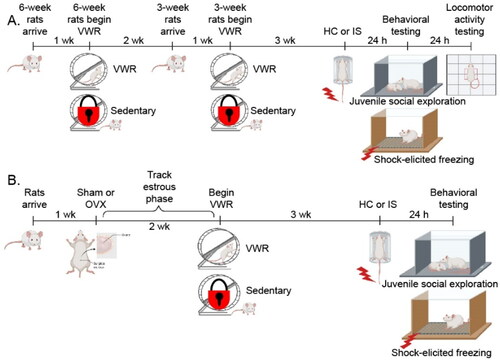
Figure 2. Sex differences in voluntary wheel running (VWR). Female and male, Sprague Dawley rats engaged in 3 (A–E) or 6 (F–J) weeks of VWR and average daily distance run during the active cycle (A and F), speed (B and G), number of bouts (C and H), distance run per bout (D and I), and bout length (E and J) were calculated. Data represent group means ± SEM. Females different from males: фp < .05, ффp < .001, фффp < .0001.
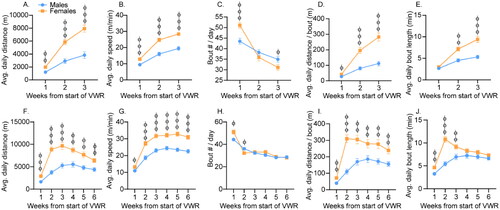
Figure 3. Sex differences in exercise-induced stress resistance. Following 3 or 6 weeks of locked wheel (Sed) or voluntary wheel running (VWR) conditions, female and male Sprague Dawley rats were left undisturbed in their home cage (HC) or were exposed to inescapable tail shock stress (IS). Behavioral testing occurred 24 h later. (A) Time experimental rats spent interacting with a juvenile conspecific in the juvenile social exploration test. *p < .05; **p < .01. (B) Size of the IS effect on juvenile social exploration in each group. (C) Percent time males spent freezing before (pre) and for 20 min after 2 foot shocks in a fear conditioning chamber. Sed IS different from Sed HC: *p < .05, **p < .01; 3 wk VWR is different from 3 wk run HC: Δp < .05, ΔΔ p < .01. (D) Percent time females spent freezing before (pre) and for 20 min after 2 foot shocks in a fear conditioning chamber. Sed IS different from Sed HC: *p < .05; **p < .01; ***p < .001. (E) Average freezing during the post-shock freezing period. IS different from HC: **p < .01. (F) Size of the IS effect on shock-elicited freezing in each group. (G) Percent time spent engaging in locomotor activity during the 2 foot shocks in the fear conditioning chamber. (I) Distance traveled in locomotor activity chambers 48 h after HC or IS treatment. *p < .05; ***p < .001. Bars and symbols represent group means. Error bars express ± SEM. Small circles in bar graphs are individual data points.
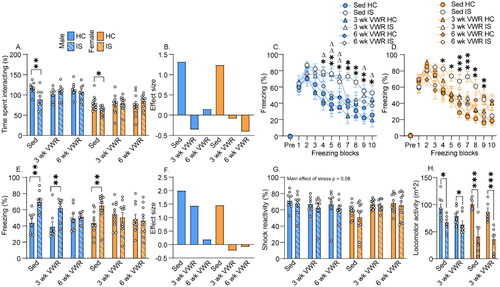
Figure 4. Corticosterone was measured from plasma collected from tail nicks at baseline (BL) immediately after inescapable stress (0HR) and 4 h after inescapable stress (4HR). ***, 0HR and 4HR different from baseline and each other (p < .0001). ффф, main effect of sex (p < .0001).
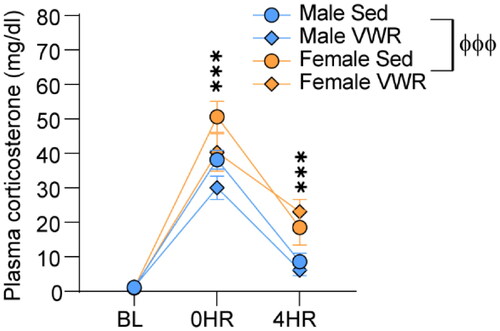
Figure 5. Effect of ovariectomy on voluntary wheel running behavior. Female Sprague Dawley rats received bilateral ovariectomy (OVX) or sham surgery (Sham) 2 weeks prior to the start of voluntary wheel running (VWR). (A) The estrous cycle was monitored for 10 d after OVX or Sham surgery. Sham rats cycled normally between metestrus/diestrus (Met/Di), proestrus (Pro) and estrus (Est), while OVX rats remained in Met/Di. Average daily running distance during the active cycle (B), speed (C), number of running bouts (D), distance run per bout (E), and bout length (F) were calculated. Data represent means ± SEM. Sham different from OVX: Φp < .05, ΦΦp < .01, ΦΦΦp < .0001.
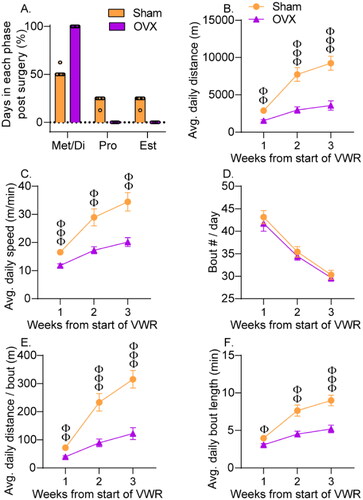
Figure 6. Effect of ovariectomy on exercise-induced stress resistance. Two weeks after bilateral ovariectomy (OVX) or sham surgery (Sham), female Sprague Dawley rats were assigned to locked wheel (Sed) or voluntary wheel running (VWR) conditions. Three weeks later, rats were left undisturbed in their home cages (HC) or were exposed to inescapable tail shock stress (IS). (A) Time experimental rats spent interacting with a juvenile conspecific in the juvenile social exploration test. HC different from IS: *p < .05; **p < .01. (B) Size of the is effect on juvenile social exploration in each group. (C) Percent time Sed rats spent freezing over 2-min blocks. Sham Sed IS different from Sham Sed HC: *p < .05, **p < .01, ***p < .001. OVX Sed IS different from OVX Sed HC: Δ p < .05, ΔΔ p < .01. (D) Percent time VWR rats spent freezing over 2-min blocks. (E) Average percent time spent freezing during the 20-min post-shock freezing period. HC different from IS: *p < .05; ***p < .001. (F) Size of the IS effect on shock-elicited fear in each group. (G) Percent time rats spent engaged in locomotor activity in the fear conditioning chamber prior to the shock. (F) Percent time spent engaging in locomotor activity during the 2 foot shocks in the fear conditioning chamber.
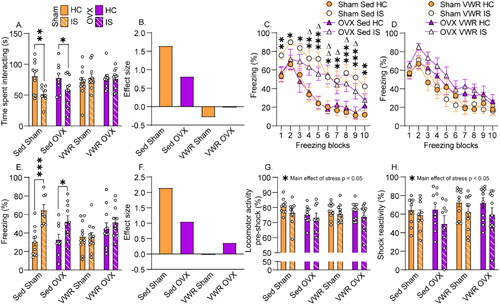
Supplemental Material
Download MS Word (395.7 KB)Data availability statement
Data will be made available on request.

